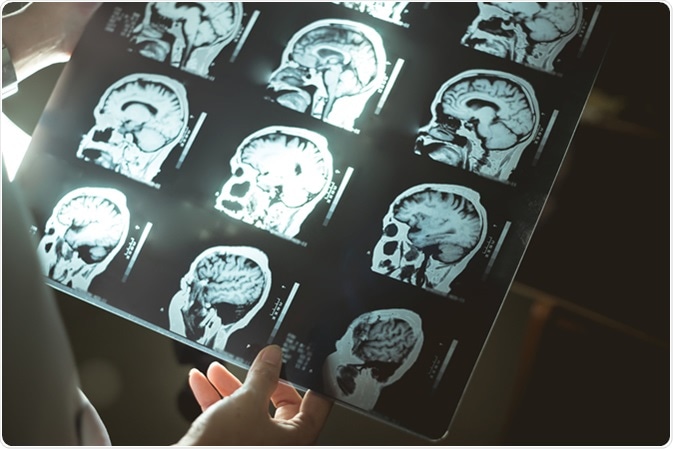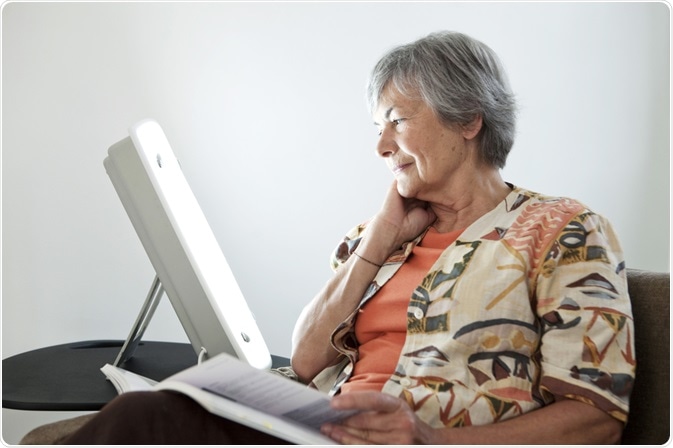Introduction
Dementia epidemiology
What is BLT?
Sleep disturbances and dementia
Efficacy of BLT for dementia patients
How does BLT work?
Conclusion
References
Further reading
Introduction
Insomnia, as well as other types of sleep disturbances, often present in dementia patients. Between 25-30% of dementia patients also report insomnia.
Bright light therapy (BLT) has been shown to treat impaired circadian rhythms effectively. Thus, BLT may be a beneficial adjuvant therapy for treating sleep disturbances in dementia patients.
Dementia epidemiology
Over 55 million people live with dementia, with about 10 million new cases diagnosed yearly. By 2050, researchers estimate that the global rate of dementia will reach over 139 million patients.
More than 60% of dementia-infected individuals live in low- and middle-income countries. In addition, in 2019, researchers reported that more women were affected by dementia than men, with this trend expected to continue to 2050.

Image Credit: Atthapon Raksthaput / Shutterstock
What is BLT?
BLT is a form of therapy in which patients are exposed to daylight or artificial light by using a special lamp. BLT is typically used in the treatment of seasonal affective disorder (SAD), which is a form of seasonal depression that occurs primarily during the winter months and is characterized by sleep and mood disturbances.
Reduced daylight in the winter months may be an important factor leading to the development of SAD due to its ability to impair melatonin production. More specifically, the increased duration of darkness throughout the winter months favors increased melatonin production, which subsequently affects mood, energy, and sleep in susceptible individuals.
BLT can be used to inhibit excess melatonin production, as well as increase synaptic serotonin in retinofugal pathways in the midbrain. Thus, artificially exposing individuals to either bright white full spectrum light or at different wavelengths is a safe and effective treatment for SAD. It is often recommended that this light exposure is provided at a distance of 30-60cm from the eyes and at a 30° angle for a total duration of 30-60 minutes.
In some individuals, BLT alone is not sufficient to treat SAD. However, this therapy can assist a considerable proportion of mild-to-moderate SAD patients. Furthermore, using BLT first thing in the morning may be the most effective time to reset circadian rhythms, thus alleviating some of the depressive symptoms associated with SAD.
One of the most significant benefits of BLT is that it is a safe and easy method for potentially treating SAD and other related disorders. This remains true even if BLT does not work for some people, depending on their routine and treatment preference. BLT may also be useful as adjuvant therapy in people with major depression and bipolar disorder, alongside pharmacological and cognitive therapies.
Sleep disturbances and dementia
Dementia refers to a group of symptoms and disorders that affect cognition and, as a result, impact daily activities. The most common cause of dementia is Alzheimer's disease, in addition to vascular dementia, dementia with Lewy bodies (DLB), and frontotemporal dementia (FTD).
Although these diseases have different causes and mechanisms, many cognitive symptoms are similar. Parkinson's disease and amyotrophic lateral sclerosis can also lead to dementia relating to DLB and FTD, respectively.
One of the main symptoms of dementia after impaired cognition is sleep disturbances. Sleep disturbances account for 39% of behavioral and psychological symptoms of dementia (BPSD). In addition to sleep disturbances, BPSD also describes depression, aggression, and anxiety, which account for 42%, 40%, and 39% of these symptoms, respectively.
The most problematic sleep disturbances are observed in Alzheimer's disease, DLB, and, to a lesser extent, vascular dementia patients.
Typically, hypnotic medications are prescribed for treating sleep disturbances; however, these are often associated with adverse side effects, including additional amnesia, increased rates of falling, sedation, delirium, and worsening of cognitive symptoms. Other non-pharmacological treatments that can be used to manage BPSD include light therapy, cognitive rehabilitation, and Snoezelen multisensory stimulation therapy.
Given the effectiveness of BLT in treating SAD and other non-seasonal depression and sleep disturbances, it may be a safe and easy treatment for sleep disturbances in dementia. In addition to its ideal safety profile, artificial light, as compared to natural light, is not impacted by adverse weather conditions and cannot harm the skin when used appropriately.

Image Credit: Image Point Fr / Shutterstock.com
Efficacy of BLT for dementia patients
Studies using BLT in Alzheimer's patients have found that the therapy is effective in treating sleep disturbances in those with a shorter duration of disease and those at a mild-to-moderate stage of illness as compared to patients with more advanced dementia.
The beneficial effects of BLT in these patients were observed between five and 11 days. One of the biggest challenges associated with BLT in Alzheimer's patients was poor compliance; however, sleep disturbances still improved in less compliant Alzheimer's patients.
Concerning vascular dementia, no significant effect of BLT has been reported. Unlike Alzheimer's, vascular dementia is considerably more variable, as disease manifestations depend on the most affected sites within the brain.
With respect to DLB, no significant improvement in sleep disturbances was observed following BLT. This is because the cause of sleep disturbances in DLB is different from that of Alzheimer's disease. To this end, insomnia in DLB is more closely related to Parkinsonian symptoms and dopaminergic impairments rather than melatonin levels.
Another recent study used daily BLT for three consecutive weeks in 37 institutionalized patients between the ages of 70 and 93. Baseline measures were obtained before therapy, with daily assessments recorded throughout the period.
This study showed significant improvement in nocturnal insomnia, diurnal hypersomnia, and sleep quality. General cognitive abilities, including memory and functional state also improved with 90 minutes of therapy for as little as five days by improving their circadian rhythms.
The results of a 24-week cluster controlled randomized controlled trial suggested that BLT, especially ceiling-mounted BLT, improved the affective symptoms of BPSD, including sadness and anxiety, within 16 weeks of receiving BLT. Week 16 represented the assessment point at which participants would have experienced the shortest period of daily natural illumination.
This study also reported significant improvements in total scores of the Neuropsychiatric Inventory Nursing Home Version (NPI-NH) and Cornell Scale for Depression in Dementia (CSDD). Notably, BLT did not prevent the deterioration of dementia during the winter months; however, it was found to generally improve symptoms in the study participants.
This study also highlighted that BLT effects take some time to develop, especially in severely ill dementia patients. This is because the physiological changes due to age and neurological disorders affect circadian photoreception. Importantly, BLT did not affect any patient's daytime sleep or the total amount of sleep, nor caused increased levels of agitation.
How does BLT work?
Researchers still do not fully understand the exact mechanisms by which BLT treats depression and agitation in older adults with dementia.
The photopigment melanopsin in ganglion cells of the retina receives and transduces bright light. The retinohypothalamic tract (RHT) subsequently transmits neural signals to the suprachiasmatic nucleus (SCN) in the anterior hypothalamus, which is the control center for circadian rhythms, sleep, and emotional responses.
Bright light also increases serotonin levels in the synaptic cleft. Light also suppresses the secretion of melatonin, a derivative of the neurotransmitter serotonin, which normally induces sleep.
Conclusions
Overall, BLT is a promising clinical treatment approach that can be used to manage mood- and sleep-related symptoms in people with dementia, with possible implications for the design of dementia units.
More research is needed to determine the ideal protocol for BLT in treating dementia patients with insomnia. Nevertheless, the current recommended protocol for administering light therapy is 10,000 lux of full-spectrum bright light from a fluorescent light box for 30 minutes every morning, five days a week.
The light box should be placed at or above eye level, positioned 30-90 cm from the light recipient at an angle of 60° or less. In specific cases, evening BLT administration is the preferred protocol.
Some older adults may require BLT twice a day, especially those who find it difficult to keep their eyes open during BLT administration.
Mayo Clinic Minute: Lift your mood with light therapy
References:
- Campbell, P. D., Miller, A. N., & Woesner, M. E. (2017). Bright Light Therapy: Seasonal Affective Disorder and Beyond. Einstein Journal of Biological Medicine 32;E13-E25. https://pubmed.ncbi.nlm.nih.gov/31528147/.
- Sekiguchi, H., Iritani, S., & Fujita, K. (2017). Bright light therapy for sleep disturbance in dementia is most effective for mild to moderate Alzheimer's type dementia: a case series. Psychogeriatrics 17(5):275-281. doi:10.1111/psyg.12233.
- Rubino, J. A., Gamundi, A., Akaarir, M., et al. (2020). Bright Light Therapy and Circadian Cycles in Institutionalized Elders. Frontiers in Neuroscience 14(359). doi:10.3389/fnins.2020.00359.
- Dementia [Online]. Available from: https://www.who.int/news-room/fact-sheets/detail/dementia.
- GBD 2019 Dementia Forecasting Collaborators. (2022). Estiamtion of the global prevalence of dementia in 2019 and forecasted prevalence in 20150: an analysis for the Global Burden of Disease Study 2019. The Lancet Public Health. doi:10.1016/S2478-2667(21)00249-8.
- Kolberg, E., Hjetland, G.J., Thun, E. et al. (2021). The effects of bright light treatment on affective symptoms in people with dementia: a 24-week cluster randomized controlled trial. BMC Psychiatry 21(377). doi:10.1186/s12888-021-03376-y
- Onega, L. L., & Pierce, T. W. (2020). Use of bright light therapy for older adults with dementia. BJPsych Advances 26(4);221-228. doi:10.1192/bja.2020.5.
- Liu, C., Liou, Y. M., & Jou, J. (2021). Pilot Study of the Effects of Bright Ambient Therapy on Dementia Symptoms and Cognitive Function. Frontiers in Psychology. doi:10.3389/fp-syg.2021.782160.
Further Reading
Last Updated: Sep 4, 2022